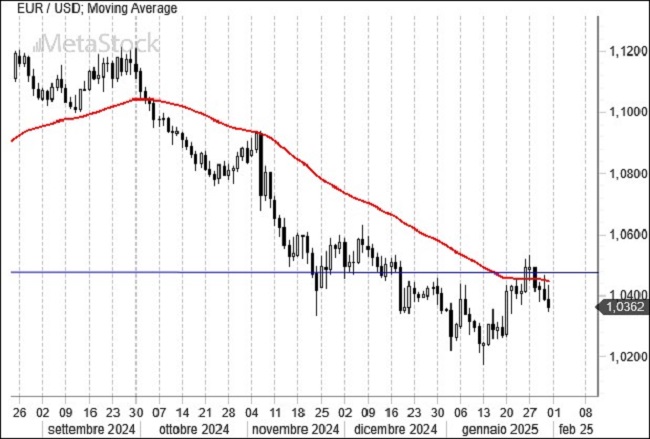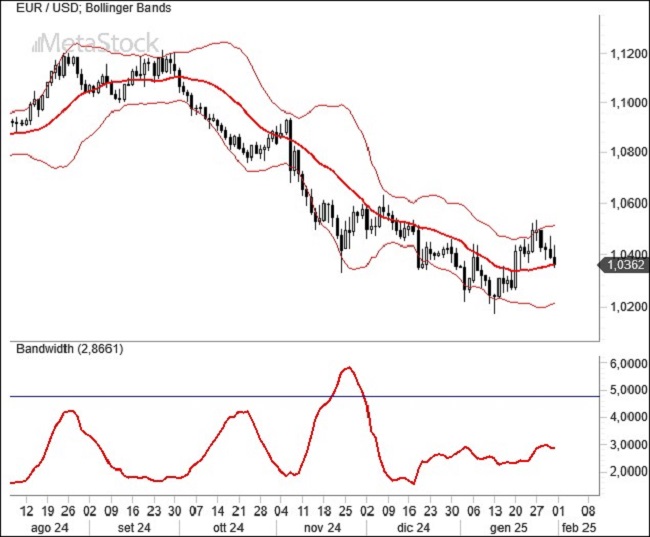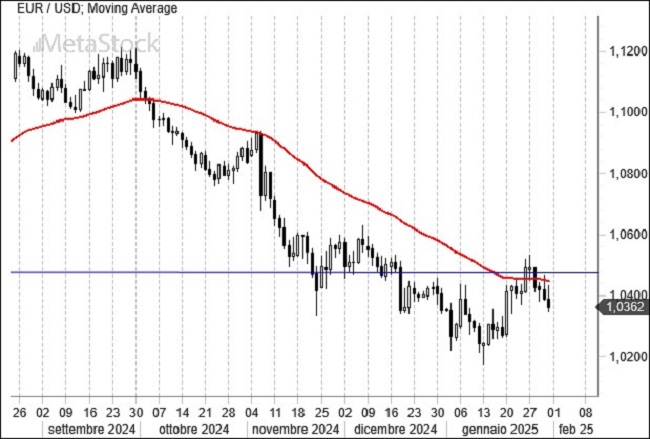- The Fed holds rates steady, indicating that inflation and economic growth do not warrant further rate cuts at this time. Powell refrains from responding to Trump’s accusations, as the latter moves forward with implementing tariffs on Mexico, Canada, and China.
- The ECB maintains a dovish stance on rates, cutting them by 25 basis points as expected. The economy remains sluggish, and fears of trade sanctions could worsen the situation.
- EUR/USD, as anticipated, has exhausted its upward momentum near the first resistance level of 1.05. A classic pullback is now underway, and it remains to be seen whether parity will be a technically achievable target this time.
Fed’s Steady Stance Amid Trump’s Criticism and Global Economic Challenges
Trump’s fiery statements following the Federal Reserve’s decision to keep rates unchanged did little to rattle Powell, who declared that the job is not yet finished. By communicating the intent to maintain the cost of money and removing references to the inflation rate converging toward the 2% target, the Fed Chair pointed to two key factors: inflation remaining too high and unemployment very low, with sectors like construction struggling to find labor. These factors prompted the FOMC to keep interest rates steady.
This stance is likely to remain until the summer, as the Fed awaits more clarity on Trump’s policies, including the tariffs, which could increase inflationary expectations. Starting in early February, tariffs on Canada, Mexico, and China are already in effect.
On the other side of the Atlantic, the ECB followed expectations, cutting rates by 25 basis points. Lagarde, commenting on the 2.75% interest rate, confirmed that the next moves would depend on inflation data. If inflation continues to converge toward 2%, as forecasted, the ECB will have no problem returning rates to neutral territory.
Meanwhile, Germany confirmed an economic recession in the fourth quarter, with numbers worse than expected—certainly not a positive message ahead of the most significant elections in Europe in 2025. Italy reported zero growth, and France saw a contraction of 0.1%.
Technical Analysis – EUR/USD Faces Resistance at 1.05, Parity in Focus
The bounce towards 1.05 has been completed as expected, with EUR/USD now moving lower. We had previously indicated that the 1.05-1.06 resistance zone would be a tough hurdle for the euro to surpass, and that has indeed been the case. The market found solid resistance in the 50-day moving average, which pushed the euro back. Now, it will be interesting to see if the dollar, having shed some of the excessive optimism that accompanied it until mid-January, can target parity. Clearly, the 1.02 area represents the most crucial technical support level.

The Bollinger Bands clearly show that the market rejected pushing the euro past the first resistance levels. Since the euro’s decline resumed, the upper band has acted as a cap on every bullish attempt in EUR/USD; this time, it has held firm.
The scenario now could either be a sideways phase that compresses volatility, with 1.02 being the lower range boundary, or a natural continuation of the bearish trend, forcing the supports lower. It’s evident that a break above 1.06 would signal the end of the dollar’s bullish market, at least in the short term.



Leave a Reply
You must be logged in to post a comment.